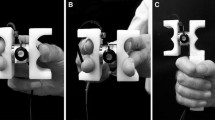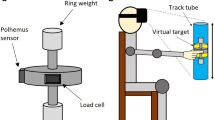Abstract
Using a precision grip, 12 participants horizontally oscillated a lightweight object at different movement frequencies (1.0, 1.5, and 2.0 Hz) under two types of elastic load. In the first (CENT), the center of oscillation coincided with the neutral position of the object in the elastic force field, leading to two peaks in load force (LF) per cycle of movement (2:1 frequency ratio). In the second (BACK and FRONT), the neutral elastic force position of the object was located outside the range of movement, thus leading to only one LF peak per cycle of movement (1:1 frequency ratio). Results showed that in BACK and FRONT the coupling between grip force (GF) and LF (as reflected by coefficients of correlations) remained strong for all movement frequencies. In contrast, this coupling decreased in CENT as movement frequency increased, with participants switching progressively from two to one GF modulation per cycle of movement. Specific evaluation of performance under conditions giving rise to comparable LF frequencies (CENT at 1.0 Hz vs. BACK/FRONT at 2.0 Hz) confirmed the effect of frequency ratio on GF–LF coupling. We conclude that the control of GF is more efficient when LF varies at the frequency of movement than when it varies at twice this frequency, especially when movement frequency is high. These results are interpreted in the context of coordination dynamics and forward modeling approach.





Similar content being viewed by others
References
Assisi CG, Jirsa VK, Kelso JAS (2005) Dynamics of multifrequency coordination using parametric driving: theory and experiment. Biol Cybern 93:6–21
Augurelle AS, Penta M, White O, Thonnard JL (2003) The effects of a change in gravity on the dynamics of prehension. Exp Brain Res 148:533–540
Blank R, Breitenbach A, Nitschke M, Heizer W, Letzgus S, Hermsdorfer J (2001) Human development of grip force modulation relating to cyclic movement-induced inertial loads. Exp Brain Res 138:193–199
Buchanan JJ, Kelso JAS, Fuchs A (1996) Coordination dynamics of trajectory formation. Biol Cybern 74:41–54
Danion F (2004) How dependent are grip force and arm actions during holding an object? Exp Brain Res 158:109–119
Danion F, Sarlegna F (2007) Can the human brain predict the consequences of arm movement corrections when transporting an object? Hints from grip force adjustments. J Neurosci 27:12839–12843
Danion F, Descoins M, Bootsma RJ (2007) Aging affects the predictive control of grip force during object manipulation. Exp Brain Res 180:123–137
De Freitas P, Markovic G, Krishnan V, Jaric S (2008) Force coordination in static manipulation: discerning the contribution of muscle synergies and cutaneous afferents. Neurosci Lett 434:234–239
De Guzman GC, Kelso JAS (1991) Multifrequency behavioral patterns and the phase attractive circle map. Biol Cybern 64:485–495
Descoins M, Danion F, Bootsma RJ (2006) Predictive control of grip force when moving object with an elastic load applied on the arm. Exp Brain Res 172:331–342
Flanagan JR, Wing AM (1995) The stability of precision grip forces during cyclic arm movements with a hand-held load. Exp Brain Res 105:455–464
Flanagan JR, Wing AM (1997) The role of internal models in motion planning and control: evidence from grip force adjustments during movements of hand-held loads. J Neurosci 17:1519–1528
Flanagan JR, Vetter P, Johansson RS, Wolpert DM (2003) Prediction precedes control in motor learning. Curr Biol 13:146–150
Flanagan JR, Bowman MC, Johansson RS (2006) Control strategies in object manipulation tasks. Curr Opin Neurobiol 16:650–659
Gilles MA, Wing AM (2003) Age-related changes in grip force and dynamics of hand movement. J Mot Behav 35:79–85
Jaric S, Russell EM, Collins JJ, Marwaha R (2005) Coordination of hand grip and load forces in uni- and bidirectional static force production tasks. Neurosci Lett 381:51–56
Jaric S, Collins JJ, Marwaha R, Russell EM (2006) Interlimb and within limb force coordination in static bimanual manipulation task. Exp Brain Res 168:88–97
Kawato M (1999) Internal models for motor control and trajectory planning. Curr Opin Neurobiol 9:718–727
Kelso JAS (1995) Dynamic patterns: the self-organization of brain and behavior. MIT Press, Cambridge
Kinoshita H, Kawai S, Ikuta K, Teraoka T (1996) Individual finger forces acting on a grasped object during shaking actions. Ergonomics 39:243–256
Kuboyama N, Nabetani T, Shibuya K, Machida K, Ogaki T (2004) The effect of maximal finger tapping on cerebral activation. J Physiol Anthropol Appl Human Sci 23:105–110
Peper CE, Beek PJ (1998) Distinguishing between the effects of frequency and amplitude on interlimb coupling in tapping a 2:3 polyrhythm. Exp Brain Res 118:78–92
Peper CE, Beek PJ, van Wieringen PC (1995) Frequency-induced phase transitions in bimanual tapping. Biol Cybern 73:301–309
Schmidt RC, Beek PJ, Treffner PJ, Turvey MT (1991) Dynamical substructure of coordinated rhythmic movements. J Exp Psychol Hum Percept Perform 17:635–651
Serrien DJ, Wiesendanger M (2001) Regulation of grasping forces during bimanual in-phase and anti-phase coordination. Neuropsychologia 39:379–1384
Summers JJ, Rosenbaum DA, Burns BD, Ford SK (1993) Production of polyrhythms. J Exp Psychol (HPP) 19:416–428
Ullen F, Bengtsson SL (2003) Independent processing of the temporal and ordinal structure of movement sequences. J Neurophysiol 90:3725–3735
Wolpert DM, Flanagan JR (2001) Motor prediction. Curr Biol 11:R-729–R-732
Zatsiorsky VM, Gao F, Latash ML (2005) Motor control goes beyond physics: differential effects of gravity and inertia on finger forces during manipulation of hand-held objects. Exp Brain Res 162:300–308
Author information
Authors and Affiliations
Corresponding author
Rights and permissions
About this article
Cite this article
Danion, F., Descoins, M. & Bootsma, R.J. When the fingers need to act faster than the arm: coordination between grip force and load force during oscillation of a hand-held object. Exp Brain Res 193, 85–94 (2009). https://doi.org/10.1007/s00221-008-1597-0
Received:
Accepted:
Published:
Issue Date:
DOI: https://doi.org/10.1007/s00221-008-1597-0




